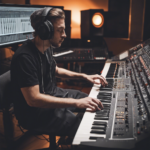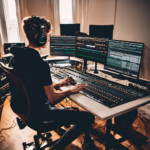
Sound Design: The Art of Crafting Unique Audio Experiences
साउंड डिज़ाइन: अद्वितीय ऑडियो अनुभव तैयार करने की कला
Sound design is an essential element in modern music production, film, gaming, and even virtual reality. It’s a creative and technical process where sound is crafted, manipulated, and blended to create an immersive experience. Whether it’s a roaring dragon in a fantasy movie, the ambient hum in a video game, or a pulsating synthesizer in electronic music, sound design is the force that brings these elements to life.
साउंड डिज़ाइन एक ऐसी प्रक्रिया है, जो ध्वनि को रचनात्मक और तकनीकी तरीके से आकार देकर उसे विशेष और प्रभावशाली बनाती है। यह प्रक्रिया कला और विज्ञान का अनूठा संगम है।
1. What is Sound Design? | साउंड डिज़ाइन क्या है?
At its core, sound design involves creating or manipulating audio elements to enhance a project’s overall impact. It encompasses recording sounds, synthesizing new ones, and processing them to fit a specific creative vision.
For instance, the roar of a dinosaur in a movie isn’t an actual dinosaur; it’s a mix of animal roars, mechanical sounds, and other audio layers blended together.यह प्रक्रिया श्रोताओं के दिमाग में एक छवि बनाने का काम करती है।
Sound design is not limited to entertainment; it also plays a crucial role in branding (think of the iconic Windows startup sound) and user interfaces (like the click of a button in an app).
2. Tools and Techniques | उपकरण और तकनीक
Sound design relies heavily on tools and software to create unique audio experiences. Let’s break this down:
a. Digital Audio Workstations (DAWs) | डिजिटल ऑडियो वर्कस्टेशन्स
DAWs like Ableton Live, Logic Pro, and FL Studio are the backbone of sound design. They allow designers to record, edit, and manipulate audio.इन सॉफ़्टवेयर के माध्यम से प्रोड्यूसर अपनी कल्पनाओं को वास्तविक ध्वनि का रूप देते हैं।
b. Synthesizers | सिंथेसाइज़र
Synthesizers like Serum, Massive, and Omnisphere are used to create electronic sounds from scratch. They allow designers to tweak oscillators, filters, and envelopes to craft unique audio textures.
c. Field Recording | फील्ड रिकॉर्डिंग
Field recording involves capturing natural sounds using high-quality microphones. For example, the rustling of leaves, chirping of birds, or the bustling sounds of a market can serve as raw material.फील्ड रिकॉर्डिंग में रियल वर्ल्ड साउंड्स को कैप्चर किया जाता है और उन्हें नए तरीके से प्रयोग किया जाता है।
d. Sampling | सैंपलिंग
Sampling is the process of using pre-recorded sounds and manipulating them. It can involve chopping up a vocal line or turning a drum hit into a new percussive element.
e. Effects Processing | इफेक्ट्स प्रोसेसिंग
Effects like reverb, delay, distortion, and pitch-shifting are used to transform ordinary sounds into extraordinary ones.यह तकनीक एक ध्वनि को अधिक गहराई और वॉल्यूम देने में मदद करती है।
3. The Process of Sound Design | साउंड डिज़ाइन की प्रक्रिया
Step 1: Ideation and Research | विचार और शोध
The process begins with understanding the project’s needs. For example, a horror movie might require eerie and unsettling sounds, while a video game may demand dynamic and responsive audio cues.
इस चरण में, साउंड डिज़ाइनर यह तय करता है कि किस प्रकार की ध्वनियाँ प्रोजेक्ट के लिए उपयुक्त होंगी।
Step 2: Sound Creation | ध्वनि निर्माण
This involves recording or synthesizing sounds. Designers might record natural sounds or use synthesizers to create something entirely new.
For example:
- A thunderstorm sound might be created by layering recordings of rain, wind, and distant thunder.
- A sci-fi laser sound might involve manipulating a sine wave with pitch modulation.
Step 3: Layering and Texturing | लेयरिंग और टेक्सचरिंग
Layering is the process of combining multiple sounds to create a rich, complex texture. For instance, the sound of a spaceship might be a blend of engine hum, wind noise, and mechanical clinks.
यह प्रक्रिया ध्वनि को अधिक यथार्थवादी और प्रभावी बनाती है।
Step 4: Editing and Processing | एडिटिंग और प्रोसेसिंग
Once the sounds are created, they’re edited and processed to fit the project. This includes adjusting volume levels, EQ (equalization), and applying effects.
Step 5: Integration | एकीकरण
Finally, the sounds are integrated into the project, whether it’s syncing with visuals in a film or responding to player actions in a game.
4. Applications of Sound Design | साउंड डिज़ाइन के उपयोग
a. Film and Television | फिल्म और टेलीविजन
Sound design is a crucial aspect of storytelling in films and TV. It adds emotion, realism, and drama to the visuals.उदाहरण के लिए, एक डरावनी फिल्म में बिना साउंड डिज़ाइन के डर का अनुभव अधूरा लगेगा।
b. Music Production | संगीत निर्माण
In music, sound design allows producers to craft unique sounds that define their tracks. Synthesizers, drum machines, and effects play a big role here.
c. Gaming | गेमिंग
In video games, sound design enhances immersion. Whether it’s the rustle of leaves in an open-world game or the intense explosions in a shooter, audio is critical to the experience.
d. Virtual Reality and Augmented Reality | वर्चुअल और ऑगमेंटेड रियलिटी
Sound design creates realistic environments in VR/AR experiences, making the digital world feel tangible.
5. Challenges in Sound Design | साउंड डिज़ाइन में चुनौतियाँ
- Creative Blocks | रचनात्मक अवरोध: Coming up with unique sounds can be challenging.
- Technical Limitations | तकनीकी सीमाएँ: High-quality tools are expensive and require expertise.
- Time Constraints | समय की पाबंदी: Projects often have tight deadlines, leaving little room for experimentation.
- Balancing Realism and Creativity | यथार्थ और रचनात्मकता का संतुलन: Especially in films and games, the sound must feel believable yet engaging.
ये चुनौतियाँ साउंड डिज़ाइन को एक अत्यधिक कुशल कला बनाती हैं।
6. The Importance of Sound Design | साउंड डिज़ाइन का महत्व
Sound design is more than just adding sound to a project; it’s about enhancing the emotional and sensory experience. A well-designed soundscape can:
- Make a horror movie scarier.
- Add intensity to a video game.
- Make a brand’s audio identity unforgettable.
साउंड डिज़ाइन श्रोताओं के दिलों और दिमागों पर एक स्थायी प्रभाव छोड़ता है।
Conclusion | निष्कर्ष
Sound design is a powerful art form that combines creativity, technology, and emotion. It is an integral part of modern media, shaping how we perceive and interact with the world around us. Whether it’s the subtle ambiance in a serene scene or the booming explosions in an action sequence, sound design has the ability to transport us to another reality.
“Sound is not just heard; it’s felt and experienced.”“साउंड केवल सुनी नहीं जाती; यह महसूस की जाती है और अनुभव में लाई जाती है।”


